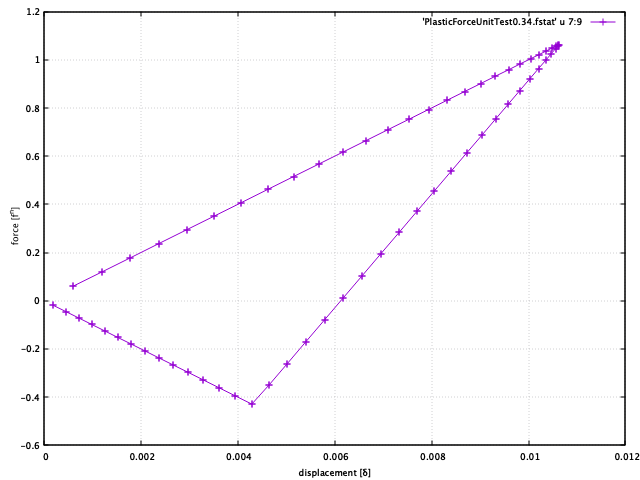 |
|
 |
|
Elastoplastic contact forces (including Dry cohesion and plasticity i.e. permanent deformation) in MercuryDPM referred to as LinearPlasticViscoelasticNormal (LinearPlasticViscoelasticNormalSpecies, LinearPlasticViscoelasticInteraction).
Plasticity models the permanent deformation of contacts due to compression. If the compression at a contact exceeds a certain yield strength, the contact area is plastically deformed. To implement this, we need to keep track of the deformation \( \delta_0 \) between the two contacts which depends on the highest state of compression a contact has been subjected to; thus plasticity is a hysteretic force. During unloading, the contact stiffness is lowered, reaching zero force when the overlap \( \delta \leq \delta_0 \) To keep the contact models simple, we keep track of the plastic deformation during contact only; as soon as the contact ends, the particle is assumed to be spherical again. The normal force is written as:
\( f_{ij}^{n} = \gamma_{n} \nu_{ij}^{n} + \begin{cases} k_1 \delta_{ij}^{n} & \quad \text{if} \quad k_2 (\delta_{ij}^{n} - \delta^0) \geq k_1 \delta_{ij}^{n} \quad \text{(loading)}\\ k_2 (\delta_{ij}^{n} - \delta^0) & \quad \text{if} \quad 0 \leq k_2 (\delta_{ij}^{n} - \delta^0) \leq k_1 \delta_{ij}^{n} \quad \text{(unloading)}\\ 0 & \quad \text{if} \quad k_2 (\delta_{ij}^{n} - \delta^0) < 0 \\ \end{cases} \)
For elasto-plastic contact forces, the dry cohesion increases with increasing plastic deformation, as the contact area gets larger. For the linear elasto-plastic model, cohesive forces can be added straightforwardly to the normal force itself. The force model is implemented by replacing the elasto-plastic normal force as follows:
\( f_{ij}^{n} = \gamma_{n} \nu_{ij}^{n} + \begin{cases} k_1 \delta_{ij}^{n} & \quad \text{if} \quad k_2 (\delta_{ij}^{n} - \delta^0) \geq k_1 \delta_{ij}^{n} \quad \text{(loading)}\\ k_2 (\delta_{ij}^{n} - \delta^0) & \quad \text{if} \quad 0 \leq k_2 (\delta_{ij}^{n} - \delta^0) \leq k_1 \delta_{ij}^{n} \quad \text{(unloading, in contact)}\\ - k_c \delta_{ij}^{n} & \quad \text{if} \quad 0 \leq k_2 (\delta_{ij}^{n} - \delta^0) \leq k_1 \delta_{ij}^{n} \quad \text{(unloading, contacts separated)}\\ 0 & \quad \text{if} \quad k_2 (\delta_{ij}^{n} - \delta^0) < 0 \quad \text{(fully separated)} \\ \end{cases} \)
The model parameters (e.g. normal loading stiffness, normal coefficient of restitution, etc) are set using LinearPlasticViscoelasticNormalSpecies member functions
Header:
Interaction function:
Unit Test: PlasticForceUnitTest.cpp
Contact behaviour:

Reference:
The implementation is based on the model by S. Luding, Cohesive, frictional powders: Contact models for tension